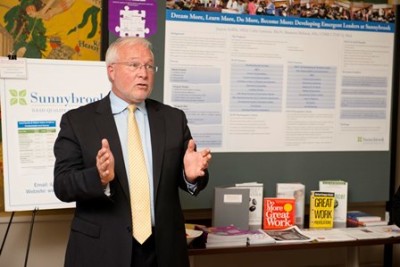Hospital boards appoint leaders but it is the health care system that builds them. Some may bring experience from the broader public sector or academia, but an #Ontario Hospital Association (OHA) survey conducted this spring found the average CEO had 28 years of health care experience – most of which came from working in Ontario. And given their ages, should these leaders choose to retire at 60, the system could lose almost half in the next three years.
#Succession planning and developing leaders has been on many hospital board agendas for some time and was identified as a key issue by the OHA five years ago. Since then, much work has been done to address the issue.
But for a health system facing frozen budgets, resource shortages, and the first drop in this country’s registered nurses in almost 20 years, what is the current state of the talent development pipeline? The next system leaders may be poised to take on the rigours of transformation, but where will the following generation come from?

“Three or four times a year I’ve had medical students approach me wanting to know how best to position themselves for leadership. And they hadn’t even graduated yet,” says Dr. Barry McLellan, CEO of Sunnybrook Health Sciences Centre. “I think it’s a very good sign.”
McLellan, like many of his colleagues, is heartened by the optimism and ambition he is seeing in this young cohort of medical and other health care professionals. But system transformation will require more than optimism and ambition.
To cultivate system leaders, some hospitals are engaging in important talent development work to identify and build leadership capacity within the system. In some ways, there is a sense of urgency behind this work because the system will see a demographic shift that threatens to deliver a double impact.
Not only will healthcare see the same wave of retiring boomers that is threatening to disrupt other sectors, but the demand for health services is also set to rise as the population ages. Essentially, a large contingent of health care workers will leave their offices, operating rooms and patient bedsides, and become the clients.
MORE: INSPIRING CULTURAL COMMITMENT
“I don’t have a sense that we’re ready for that demographic bulge or what’s going to happen on the consumer side with this aging cohort,” says Ray Racette, president and CEO of the Canadian College of Health Leaders, an organization focused nationally on identifying, developing and supporting leadership in healthcare.
Despite the work he is seeing in health care leadership development and the relative stability he is seeing in Ontario hospital leadership, Racette says it’s important to pay attention to this shift.
“It’s a time to be a little nervous,” he says.
The growing complexity of the leadership role and an aging cohort has some observers also worrying about the short-term future of the system’s current leaders. As the retirement wave washes through industries and sectors, a significant exit of these leaders, specifically #hospital CEOs, could cause further disruption for a system in the midst of transformation.
The OHA’s current demographic figures on this province’s hospital CEOs say that half fall into the 52-to 59-year-old age bracket. And the rate of retirement is accelerating – from four perc cent in 2012 to 11 per cent in 2014. Seeing more senior leaders considering retirement begs the question: Are there enough in-line who are ready to replace them?
The most likely source of CEOs, it seems, is another hospital’s senior team. The OHA survey found that 60 per cent of the responding CEOs had been senior executives before taking on their role. But a look at the OHA’s 2014 HR Benchmarking survey found that the external job fill rate was significantly higher than the internal job fill rate when it came to CEO and senior hospital executive positions. In short, most CEOs appear to come from senior levels and from other hospitals.
External candidates are more common for hospitals in large urban markets like Toronto, as was the case for Sarah Downey, President and CEO at Toronto East General Hospital. Downey took the reins of this community hospital in April of this year, having been an executive vice president at The Centre for Addiction and Mental Health (CAMH) and a vice president at the University Health Network before that.
“I think there are a lot of highly qualified candidates out there who are ready to make that shift,” she says of the CEO candidate pool. When she was contacted in 2014 to gauge her interest in leading a hospital, there were eight CEO searches across Canada underway at the time.
Barbara Nixon is not surprised by these numbers. A partner in the executive search firm Promeus, she says her team has worked on three CEO searches in the last 18 months, is currently working with Thunder Bay Regional Health Sciences Centre and Thunder Bay Regional Research Institute to find its new top executive, and is potentially involved in two other CEO searches.
MORE: HEALTH RESEARCH: SOME OF THE YEAR’S MOST REMARKABLE ACHIEVEMENTS
Nixon thinks health care organizations have more work to do to improve succession. “They are getting better at it, and people are recognizing it’s important, but I would say that over the last decade it’s not something the health system has focused on,” she says, explaining that most recruiting firms encourage a search that includes internal candidates but that hospital boards tend to want an external search to ensure that there has been a competitive process.
“We’re at an interesting juncture in terms of not only getting the right talent and the right skills but also making sure [senior managers] want the job,” says Nixon.
While many senior leaders tend to come from other hospitals to take on a CEO role, boards are also careful to assess and develop internal talent. And if they want to maintain a current strategic direction, it can be even preferable.

When Bluewater Health’s president and CEO Sue Denomy announced her plans to leave in 2015, an internal candidate was deemed important for continuity. Vice president of operations and chief operating officer Mike Lapaine was interviewed and selected by the board and will take on the CEO role in January of next year.
“The decision to hire an internal candidate over an external one really depends on the situation of the organization at the time,” says Lapaine, citing the importance of a senior executive’s pre-existing relationships with external health care partners in the community as an important factor. Sue Denomy says this is one of the key traits for successful CEOs in the current health climate.
“It’s not enough to go the traditional route of being an accountant to manager of a department, to director and VP. The skill set needed now is one that understands broad performance such as utilization rates and understanding the impact of the hospital within the community,” she says, adding that with system change, it’s important for CEOs to be able to understand what is best for the community rather than what is simply best for the hospital.
This type of broader approach to leadership thinking is at the heart of most leadership training. Bluewater’s own formalized leadership training is in its third year and it partnered with Lambton College to launch a Board of Governor’s certificate program for leaders. But future leadership, Denomy offers, should also be understood in the hiring processes at levels below senior executives.
“You should be recruiting with the notion that you want to keep them and advance them. Rather than hiring for a single position, consider what’s ahead and what opportunities they could grow into,” she says.
Large- and medium-sized hospitals are more likely to have a robust leadership development system at work, but all hospitals have the opportunity for staff to understand and even participate in the development of care in the community.
MORE: LET’S RID THE WORLD OF SUICIDE
Sunnybrook’s senior team is part of a number of processes outside the hospital, from Health Links to LHINs to ministry of health projects; it works to find new ways to provide care outside the hospital, explains CEO, Dr. Barry McLellan.
He sees the next generation of senior leaders not only as assets to the hospital, but as stewards of the health system itself.
“They need to be system leaders and spend more time on issues like how best to provide primary care, and how community care can, frankly, prevent people from coming to hospitals and help them to get out of hospitals sooner,” he says.
It’s a team-based approach but where the team is beyond the hospital walls so that the skill is not only in partnering, but also in having a lens on the needs of the patients and how a system can deliver that, he explains.
While healthcare has some learning to do in the area of leadership development, Sunnybrook stands among those taking matters into its own hands. The hospital’s Leadership Development Institute works with U of T’s Rotman School of Management and York University’s Schulich School to deliver leadership programming for middle and senior managers, and initiatives such as its strategic workforce planning retreat, tackles succession planning and allows managers to discuss emerging leaders and their development. It’s an environment where leadership is seen as a shared resource.
“We’re growing talent and we have leaders growing within the organization, but if individuals benefit from our leadership training and go off to work for another hospital in a more senior leadership position, that’s great for the system,” says McLellan.
Southlake Regional Health Centre’s president and CEO Dr. Dave Williams holds a similar perspective on the importance of taking a broader view on building leadership capacity because, as he puts it, the big changes in healthcare are going to occur at a system level.
“We can support emerging leaders by decreasing the competitive aspect and placing a greater importance on collaboration,” he says. Southlake is one of the six GTA and York Region hospitals that make up The Joint Centres for Transformative Healthcare Innovation, which served to formalize the knowledge sharing in which these hospitals were already engaged.
Designed to share innovative ways to improve patient care and increase efficiency, it’s a collaborative unlike any in the province. And it serves as a means for partners to identify talent in various organizations.
“If you are developing a leader and they’re good but they don’t have the opportunity to move up, you run the risk that they will find a job elsewhere. In that case, what they’re doing is bringing your organization’s best practices to a new organization. And that’s immensely powerful,” he explains.
Williams sees consumer expectation as the next big force of change in healthcare. If the goal of the system is to maintain wellness and meet needs, then leaders have to understand not only how to work with families and patients, but how to work with other providers and institutions to deliver better care.
MORE: ELIMINATING PREVENTABLE HARM TO PATIENTS AND STAFF
That’s why the notion of building leaders for the system is so important, says Williams, because it cuts to the heart of the matter. “Not everyone who needs healthcare goes to a hospital.”
As a broad approach to system leadership takes root, the OHA’s president and CEO, Anthony Dale, points out that the current hospital leadership has been driving change in a number of ways.
“Ontario’s fiscal challenges have generated new ways about thinking about health system transformation, and hospital leaders have been at the centre of this innovation, driving forward with quality improvements, such as integrated funding models for post-acute care, funding reform and health hubs,” explains Dale. “Thanks to this leadership, hospitals are becoming more efficient and providing better quality of care for patients.”


